
All scans
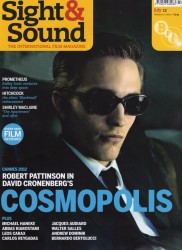

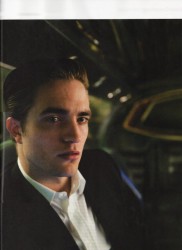
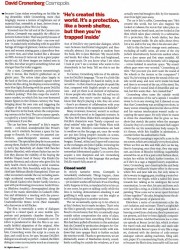
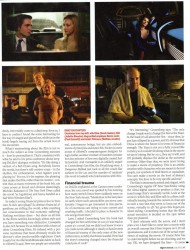
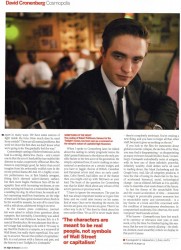
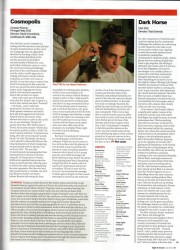
Transcript
Received wisdom has it that only bad novels, or at least disposable ones, stand a chance of becoming good films. Supposedly, any attempt to film a good novel is doomed to failure - or at best to result in quixotic half-measures. But that a prestigious book by a major writer should actually improve in translation to the screen is, according to this unspoken law, unheard of. Yet this is the case with David Cronenberg's Cosmopolis, based on the 2003 novel by Don DeLillo, in which a young billionaire financier, Eric Packer, crosses Manhattan in a stretch limo and contemplates the downfall of Western capitalism, while cruising in search of a haircut and his own ultimate perdition. It's like the Forbes 100's Journey to the End of the Night.
In Cronenberg's sleek, eerily numbed reimaging of the book, Packer is played by erstwhile Twilight heartthrob, Robert Pattinson, clearly no stranger to limo living. By bizarre coincidence, Cosmopolis was one of two white-limo fantasias in the Cannes competition, the other being Leos Carax's Holy Motors, in which the car is occupied by a protean existential everyman. For my money, Cosmopolis is by far the stranger of the two films, because Carax stakes everything on his film being dreamlike, while Cronenberg, more challengingly, weaves a texture of nightmare out of material that, ostensibly at least, derives from a realist musing on How We Live Today.
Screened near the tail end of the Cannes competition, Cosmopolis was arguably the official selection's hottest ticket. That was partly because of a punchy, tantalising trailer that - one now realises - is audaciously misleading with its quickfire barrage of images of glamour, violence and chaos: men and women aiming guns, a dancefloor frenzy, street riots, and what looked like a dinosaur on Fifth Avenue (it turns out to be a giant papier-maché rat). All these images are indeed seen in the film, but what we get is something richer and stranger than the trailer suggests.
For a start Cosmopolis proves mesmerizingly slow; it moves, like Packer's gridlocked car, at glacier pace. The action takes place largely in the back of the limo, an insulated capsule where Packer sits like a king, his display screens emitting eerie blue light, flickering with (to quote DeLillo) "flowing symbols and apline charts...polychrome numbers pulsing". This data maps the world finance market, on which Eric has over-borrowed insane figures in the Chinese currency the Yuan, bringing about his own ruin and triggering the collapse of the world economy (something less clear than it is in the book, where the comprising currency is the Yen). The car is a space capsule, occupied by a lonely Major Tom of world finance - a plutonaut, if you like.
The car has been "prousted" to Eric's requirements - cork-lined, soundproofed like Proust's study, and it similarly becomes a space for language to flourish. It's a venue for assorted conferences, quasi-therapeutic sessions, sexual encounters. The specialists drop by in succession: among them, Packer's chief of technology Shiner (a nervy Jay Baruchel); art dealer Didi Fancher (Juliette Binoche), with whom Packer has sex before they discuss the viability of his buying the Rothko Chapel; head of theory Vija Kinski (Samantha Morton); and a doctor who gives Eric his daily health check, including a rectal examination, while Eric flirts feverishly with his finance chief Jane Melman (Emily Hampshire). There are other encounters outside the car, including seemingly accidental meetings with Else, the poet wife (Sarah Gadon) who Packer hardly knows; a spat with pie-throwing provocateur André Petrescu (Mathieu Amalric), choreographed along the lines of the maniac skirmishes with Godard's Détective, and ultimately a meeting with the proverbial Disgruntled Former Employee, deranged Unabomber-like Benno Levin (Paul Giamatti), who has sworn to kill Packer.
The film is essentially a series of dialogues staged in a closed space: at once mobile symposium and peripatetic chamber theatre. The superiority of Cronenberg's Cosmopolis over DeLillo's is paradoxical in that the film is an unusually faithful adaptation of the original. After producer Paolo Branco proposed the project to him, Cronenberg wrote the script in a mere six days, and could do so, he says, because DeLillo's dialogue was already so perfect - indeed, the film's dialogue comes across pretty much as transcription of DeLillo's very particular dialogue, which veers between hard-boiled telegraphic and theoretically abstract. (An example at random from the book, Eric to Jane Melan: "My mood shifts and bends. But when I'm alive and heightened, I'm super-acute. Do you know what I see when I look at you? I see a woman who wants to live shamelessly in her body. Tell me this is not the truth.")
In Cannes, Cronenberg tells me of his admiration for DeLillo's language. "To me it's a little like Harold Pinter dialogue. It's based in reality, in observation-in that American people do speak like that, compared with English people or Australians-and yet there is an element of stylisation. I know people who talk like that. It's real but it's also surreal. Any movie you're making, we all know that they're playing a role, they are actors-there's an element of collaboration with your audience in terms of the suspension of disbelief."
Many reviewers, however weren't so enthusiastic about the novel or its linguistic textures. In The New York Times Walter Kirn complained that DeLillo's characters were "barely corporeal cerebral entities" who spoke like "Palm Pilots with lips". For sure, DeLillo's conversations are hard to swallow on the flat page; yet, once the words are put into living people's mouths on screen, something peculiar happens: it becomes Cronenbergian. Formal, stilted and hyper-self-conscious as the exchanges are John Updike, reviewing the book, referred to the dialogue's "terse, deflective, somewhat lobotomised quality"), on screen they acquire a new sharpness and wit. Cronenberg has found comedy in this language that perhaps DeLillo wasn't fully aware of.
Closed world
In strictly narrative terms, Cosmopolis is remarkably undramatic. Things happen, chaos explodes in Eric's orderly "microtimed" existence-yet incident washes off his back. It's as if nothing really happens to him, so insulated is he in his car. In one scene, he goes on talking coolly while the limo is rocking, demonstrators attacking it and graffiting it with spray cans-yet this might as well be taking place in another universe.
The car occasionally opens up to let others in at Eric's behest, but it repels invaders. That's why the film is generally most compelling when confined to its enclosure, that Eric occasionally steps outside rather compromises the unity of place, and it would have been something if the whole film had been pulled off entirely in this ambulant huis clos. Created by production design Arv Grewal, the limo is a dark, opulent womb, with windows that turn opaque black to further exclude the exterior world. Thanks to greenscreen, we are distractedly aware of Manhattan slowly, soundlessly scrolling by outside the windows, as if not actually seen but brought to Eric by live transmission from light years away.
The car is Eric's coffin, Cronenberg says. "He's created this world, but he's also trapped. We looked at Lebanon the movie that takes place entirely inside an Israeli tank, and we looked at Das Boot, which takes place entirely in a submarine. It's protection, like a bomb shelter, but then you're trapped inside. He also talks about elevators a lot, and in the way this is his elevator also."
Add to this limo's strange sonic ambience, excluding all traffic noise, all sense of the city (which intermittently bursts into earshot whenever a door opens and Eric steps outside). All that really exists in this hermetic cell is language-voices isolated in anechoic space. "My sound effects guys were very worried," Cronenberg admits. "Are you sure you don't want the sound of the wheels or the motors or the computers?" I said, 'No, he's trying to keep the sound of the outside world away, and now we're inside his head and there is no sound of the car, of the street. Yes, it will make it sound kind of dreamlike and surreal, but Eric wants that-he's created that.'"
Cronenberg often turns the outside world into a extension of the car's capsule. I wouldn't swear to it on one viewing, but it dawned on me that Cronenberg was avoiding two-shots, in many scenes stressing shot/reverse shot as if Eric and his various interlocutors weren't really occupying the same space. It's only when he wants to stress the claustration that he gives us two-shots that stretch the point: when the manager (Gouchy Boy) of a recently deceased Sufi rapper enters the car, his mountainous body usurps Eric's throne, while Eric huddles in admiration, a courtier before his authoritative bulk.
This spatial cramping is especially acute in the sex scenes, which are comically over-physicalised. When we first see Eric and Didi, she's on his lap, they're humping; once they stop, they stay separate, and shots of Binoche writhing coquettishly around the car, as if in a post-coital fashion shoot, isolate her within its black leather interiors. It's as if she's in a cage, a trapped luxury acquisition. Later, Cronenberg uses claustrophobia and body language to brilliantly bizarre effect in the scene where Eric and Jane talk sex, but only mime it: she's sweaty in jogging gear, crushing a water bottle between her thighs, while a naked Eric leans towards her, talking as he undergoes his rectal examination. In one shot, his arm and torso arch over Jane like a wing, or a limb in a Francis Baon painting. "How come we've never spent this kind of time together?" she asks, bringing home the absurdity of this parody of glamour sex.
Elsewhere a series of environments echo the car's isolation and enclosure. There's a nightclub scene in which Eric and a bodyguard watch a heaving crowd from a balcony; they're present yet not present, as if they've been digitally composited into the action. And the final scene is a 22-minute episode at Benno's Levin's lair, which is where the travel ends and theatricality and stasis take hold absolutely. Benno's space is very like a stage set, cluttered with detritus of 20th-century analogue culture: adding machines, filing cabinets, paper. It's a mesmerising finale, all the more so because the film's slow, inexorable roll has suddenly, irreversibly come to a dead stop. Even so, I have to confess I found the scene fascinating for the way it's staged and played out, while (as in the book) largely tuning out from the actual text of the encounter.
What's mesmerising about the film is not so much the subject as how Cronenberg executes it-how he personalises it. That's consistent with what he said in his press conference about keeping DeLillo's dialogue verbatim: "It's like doing a version of a Bob Dylan song. Everybody knows the words, but there's still creative scope-in the rhythm, the orchestration, what register you're playing in." For me, it's the register, the phrasing that makes the film, rather than its content-content that, as many reviewers of the book felt, can come across as forced and obvious (damningly, Michiko Kakutani of The New York Times called the novel "as lugubrious and heavy-handed as a bad Wim Wenders film").
So today's young financial princes live in their own hi-tech sarcophagi? So abstract financial algorithms are stifling the world, while numbing our consciousness to real economic suffering? Nothing revelatory there-but show us all that in the film's rarefied, knowingly airless style and you have something distinctive, Cosmopolis is also rich because it's so redolent with echoes of other Cronenberg films. It's infused with a perverse numbness that most obviously recalls the director's other psycho-mobile nightmare Crash (1996), but its otherworldliness also takes us back to eXistenZ (1999). Here too people are ostensibly real, autonomous beings, but are also embodiments of principles and states: Eric Packer is a new avatar of eXistenZ's computer-game designer Allegra Gellar, another creature of numbers (creator but also prisoner of her own digitally created hallucination). And Cosmopolis is an unlikely sequel to Cronenberg's last film, the Freud-Jung story A Dangerous Method; just look at all the couch-like surfaces in the car, and the number of 'analysts' (the word is loaded) who hold sessions with Eric.
Financial trauma
As DeLillo explained at the Cannes press conference, his 2003 novel was sparked by noticing how many stretch limos there suddenly were on the New York streets. "Manhattan is the last place on earth where such automobiles can move comfortably. I began to get interested in this spectacle of enormous cars trying to turn corners and crushing traffic. I decided to place a character in one and go from there."
Later, I asked Cronenberg how the book had changed for him with time, in 2003 it was read as a post 9/11 novel, but we didn't yet know it was a pre-crash novel, although it clearly echoed events of financial trauma of the early years of the new millennium, notably the Enron scandal. How had the story's meaning changed since the financial cataclysm of 2008?
"It's interesting," Cronenberg says. "The only change I made was to change the Yen to the Yuan. In the book it's all about the Yen-since then, Japan has collapsed as a power, and it's obvious that China is where the future is in terms of financial strength. The Yuan is not yet a fully convertible currency so it couldn't be doing what in the movie we say it's doing. But by 2015, they say it will, and it'll probably displace the dollar as the universal currency. Other than that, we were never trying to make a movie of prophecy. This is an artistic creation with characters who are meant to be real people, not symbols of Wall Street or capitalism. You can't make a movie on the level of abstract concepts. You have to be very specific and real."
The film is immensely poised and elegant, with Cronenberg's regular DP Peter Suschitzky using the Alexa digital camera to produce a clear, textured image that's usually tactile. Looking at the scene in which Eric and Elise talk in a diner, individually leaning towards the camera in close-ups in such a way that they seem to loom out of the screen, virtually in 3D. Yet, given this hyper-polished styling, Cronenberg insists that the film's actual execution is decided on the spot rather than pre-planned.
"I don't rehearse with the actors, and I don't plan a lot. I don't like to come into a movie with an overall concept that I then impose on it. It's all spontaneous, and it comes out of the actual experience of making the movie. Of course Peter has to order his lights before we are shooting and we say, 'OK, we have designed the limo-it comes apart in many ways. We have some sources of light inside the limo. How much does he need from outside?' These are all normal problems. But until we shoot hte first shot, we don't know what we're going to do. You gradually feel the way."
Cronenberg's casting of Robert Pattinson as his lead is a strong, distinctive choice-and a smart one in that the actor's bankability has enabled the director to make a supremely offbeat art film. Pattinson is surprisingly good, far better than you'd imagine from his awkwardly wolfish turn in the recent period drama Bel Ami. It's a high eccentric performance too, at first blankly arrogant, fitting Eric's sheened tailor's dummy surface, but then more fragile. Pattinson fires off his telegraphic lines with increasing tetchiness, at one point rocking his head on a motionless body, like a nodding toy dog. At other times, he sounds as if he's repressing small-boy brattiness, on the edge of tears; and he has a great moment when, fired on by his would-be assassin, he sets off to meet him with a ridiculous, adolescent bring-it-on strut.
At the Cannes press conference, journalists were asked to refrain from questions about vampires. But inevitably, Cronenberg was asked whether he'd cast Pattinson because Eric is a financial bloodsucker. He was adamant that the actor's image had nothing to do with it: "It's easy to say that Eric Packer is a vampire, or a werewolf of Wall Street, but really that's superficial. You can’t say to an actor, 'You are the symbol of capitalism.' Eric is a real person with a history and past, and the history is not Twilight it is Cosmopolis."
When I spoke to Cronenberg later, he talked about the casting in calmly pragmatic terms. He didn’t praise Pattinson to the skies as the only possible Packer or the best actor of his generation. He simply explained how, if you're making an international co-production on a certain budge, and you have to juggle choices of British, Canadian and European actors (and since an early candidate, Colin Farrell, had fallen out of the frame) then you might end up with Pattinson as your lead. The heart of the question for Cronenberg was that he didn't think about any echoes of the actor's persona or previous work.
"I have to ignore the resonances. The past for Rob was always important insofar as it gave him fame and we could raise money on his name. End of story. Once we're shooting the movie, his movies are gone, my movies are gone. There's no other way to do it." Nor does he think about his own earlier films. "It's as if I've never made them-they're completely irrelevant. You're creating a new thing, and you have to forget all that other stuff, because it gives us nothing on the set."
If you look to the film for statements about global economic collapse, the decline of the West, you may find it disappointing-as disappointing as many reviewers found DeLillo's book. Cronenbrerg's Cosmpolis undoubtedly reeks of zeitgeist, with its hero one of those infinitely powerful, infinitely wealthy child deities we're all used to reading about, like Mark Zuckerberg and the Google boys. And, like all zeitgeisty products, it runs the risk of losing its sheen fast in the face of accelerated historical, social, technological change-just as eXistenZ, brilliant as it is, quickly came to resemble a last-week dream of the future.
In fact the theme of the uncatchable Now and the crazed acceleration of time-measured no longer in perceivable present moments but in uncatchable zepto- and yoctoseconds- is a key theme of a book and film concerned with the condition of instantaneous obsolescence. In computerised modernity, Eric observes, the word 'computer' itself sounds archaic.
Who knows-Cosmopolis may have lost much of its currency or relevance next year, or next week, or by the time I've finished typing this sentence. But for now it's utterly alluring-the sleekest, shiniest, most unearthly vehicle on display in this year's Cannes.
scans transcript
Scans via Robsessed via cosmopolisfilm Transcript RPattzDaily via RPLife
Via
Posting: riesty ^^

No comments:
Post a Comment